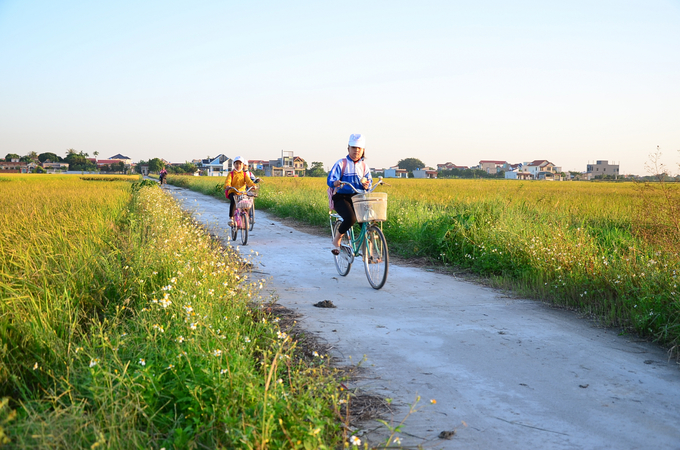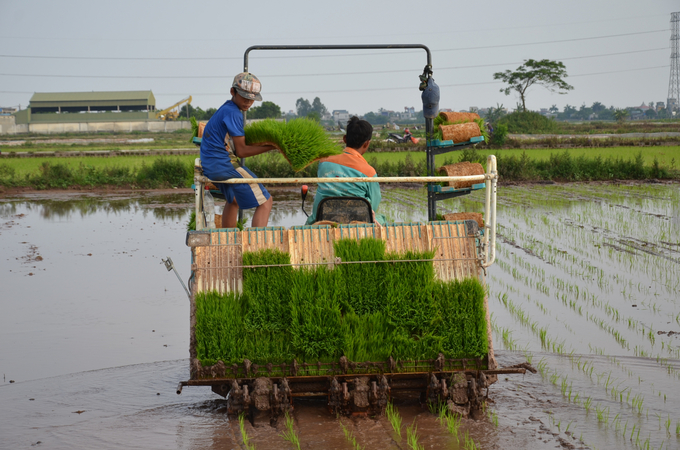June 19, 2025 | 03:41 GMT +7
June 19, 2025 | 03:41 GMT +7
Hotline: 0913.378.918
June 19, 2025 | 03:41 GMT +7
Hotline: 0913.378.918
Drawing lots and being able to pick up a few plots of fields, no matter big or small, good or bad, Bui Van Hanh’s family in An Tiem 3 village, (Thuy Dan commune, Thai Thuy district, Thai Binh province) still felt so happy as if they wanted to burst into tears of joy.
The family’s seven members included him and his wife, his parents, his aunt, and two children. Each person had 1.8 sao (1 sao equals 360 m2), but the varieties planted were all perennial ones such as Quyet Tam, Danang, Bao Thai which gave a yield of 100 – 120 kg/sao, so it was still not enough to feed the belly. Being so hungry, they even dug up mud from the 1 m wide banks of water taro to make field and switch to rice cultivation.
Above, buffaloes ate, below, ducks huddled, in the end, there were only two rows of rice left. They still tried to look for a few grains of rice to hold on to. Hanh and his wife even make full use of the plots used to tie the buffalo, tidying them up to start transplanting.

Children going to school along the Rung paddy field. Photo: Duong Dinh Tuong.
In the early years Hanh’s family had to rent fields for a fee of 40 – 50 kg of rice/sao, now the fee is only 25 kg/sao, even 8kg/sao in low-lying, bad places. More than 12 ha of his home's field is formed like that. "In the near future, Lien Ha Thai industrial park will be put into operation. It will empty the labor of villages, many fields will be left behind, and that’s an opportunity for people like us," Hanh said.
If it was in the past, transplanting 1 – 2 mau (1 mau equals 10 sao) would take Hanh 15 days to complete, but now he can plant 12 ha with the same amount of time. The same goes for the reaping stage. It used to take Hanh more than 10 days to reap 1 – 2 mau, now he can harvest his 12 ha field in just 10 days. The rice remains fresh on the field, ready to be sold. “In the past, houses that had a stack of three-valve rice grains containing 1.2 tons was enough for the farmer to swagger in front of their neighbors. Now I can make approximately 70 tons of rice in each crop. Just the extras and bad grains used as feeds are already around 1.2 tons,” Hanh said.
I slept at Hanh's house that night, listening to the couple’s discussion: "This year's rice has such good plots, evenly smooth like a thatched roof”. “…You have to describe as good as those strong plows because the rice all bend down and turn the cotton to one side." In the morning, I followed Hanh to the Rung field. A sea of golden rice in the morning sun, the morning dew at the tips of the leaves shines like pearls. Immersed in autumn’s cool breeze, the scent from the fields sticks like glue, clinging onto me without leaving a step.
Ngo Thi Luyen – another “big farmer” in An Tiem 2 village (Thuy Dan commune) said, “In 2001 the field was still so rare that it was laid out for bidding at 75-80 kg of rice/sao. The yield of good rice was only 150 kg/sao. Minus the cost, only 10-20 kg of rice is left. We call it ‘doing enough work to get by”.

Children also help adults in the field. Photo: Duong Dinh Tuong.
Back then she worked on 2 – 3 mau of fields, all by hand. The labor was only VND50,000/session, now it is VND 250,000/session, and the auction price is gradually reduced from 60, 50, 40 and finally 25 kg of rice/sao. When she quit her job as a knife merchant to gather more fields, her husband, who worked as a blacksmith, said, "People leave agriculture to become merchants, you are one already, so why go back to the rice fields?"
Ignoring those words of derogatory, she still put her soul into her 30 mau field. During the transplanting stage, she went to the field with the workers from morning to night for 15 days straight. The meal was only a 15-20-minute rush just so she could overcome her hunger. There were days when the harvest was finished, and the drying rice was gleamingly yellow all over the village road, but a sudden rain came, and the whole neighborhood had to bring out the brooms and went for the rescue. Luyen quickly pulled out the straws that block the sewer holes, but she couldn't make it in time. Seeing the yellow rice drifting down, her tears would not stop pouring down.
Later, when rice became abundant, she switched to selling it fresh right in the field. Sometimes the weighting could not be done in time, causing the rice to pile up in the field. Her husband had to hang a curtain on the buggy to keep watch in her stead for a few nights. In times of rainy days, even though the rice didn't get wet thanks to being covered, there were hundreds of sellers while buyers were few in number, so the pressure on price was immense.
"Hiring people at all stages, I make a profit of VND 300,000/sao. If we calculate on the scale of 30 mau, that would be VND 80-90 million per crop, VND 160-180 million per year. Planting 20 mau of fields and the income would equal to workers' wages of VND 6- 7 million per month, but less than 10 mau won't work. I can expand the area, but because I can't dry rice myself, I don't dare to do it," said Luyen.

The “golden season” in the land of Thai Binh. Photo: Duong Dinh Tuong.
Mai Thanh Giang, Director of Thai Binh Plant Protection and Crop Production Sub-Department, said that the province had 91,000 ha of agricultural land, and 76,000 ha of which were rice. in the period from 2013 to 2018 rice production slowed down because it only gave an income of VND 70-80 million/ha. Minus the remaining costs, the profit was very low. “Fortunately, there are still forces who love agriculture in the countryside. At first they took the fields from the brothers and then from other neighbors. The Sub-Department discovered such individuals, and later we held a meeting to discuss development trends. Thus was born the Great Farming Association, meeting twice a year in the spring and summer crops.”
Translated by Samuel Pham
![Turning wind and rain into action: [9] Digitizing hydrometeorological data in response to climate change](https://t.ex-cdn.com/nongnghiepmoitruong.vn/608w/files/news/2025/06/17/z6704423696987_15fd32ffc26d590d204d520c9dac6786-nongnghiep-165943.jpg)
(VAN) Farmers have begun accessing hydrometeorological applications to adjust their cropping schedules, aiming to ensure productivity and adapt to climate change.
![Turning wind and rain into action: [8] Real-time salinity detection and early warning technology](https://t.ex-cdn.com/nongnghiepmoitruong.vn/608w/files/news/2025/06/17/z6704423696987_15fd32ffc26d590d204d520c9dac6786-nongnghiep-151127.jpg)
(VAN) Thanks to the integration of modern hydrological-hydraulic models, remote sensing technologies, and artificial intelligence, the accuracy of hydrological forecasting has significantly improved.
![Turning wind and rain into action: [7] Early disaster warnings help marine farmers minimize losses](https://t.ex-cdn.com/nongnghiepmoitruong.vn/608w/files/news/2025/06/17/z6704423696987_15fd32ffc26d590d204d520c9dac6786-nongnghiep-142942.jpg)
(VAN) In recent years, thanks to early disaster warnings and forecasting, marine farmers in Khanh Hoa province have been able to reduce risks and losses, thereby improving production efficiency.
![Turning wind and rain into action: [6] ‘Four on-the-spot’ disaster management software](https://t.ex-cdn.com/nongnghiepmoitruong.vn/608w/files/news/2025/06/17/e5a48259d6a262fc3bb3-nongnghiep-183800.jpg)
(VAN) By simply activating the scenario on the disaster management software, the relevant authorities immediately know how many households need to be evacuated, where to evacuate them to, and by what means of transportation…
![Turning wind and rain into action: [5] Hue applies modern technology in disaster forecasting](https://t.ex-cdn.com/nongnghiepmoitruong.vn/608w/files/news/2025/06/17/z6704423696987_15fd32ffc26d590d204d520c9dac6786-nongnghiep-093938.jpg)
(VAN) In Hue city, modern technology has recently been applied in meteorological and hydrological forecasting and warning, helping to reduce the damage caused by natural disasters.

(VAN) A cutting-edge farming technique being implemented on an experimental ranch in Arizona's Sonoran Desert has already saved a billion gallons of water over five years, according to Civil Eats.

(VAN) Poultry and pig production and the environment can be boosted through enhanced water technology, according to new research.